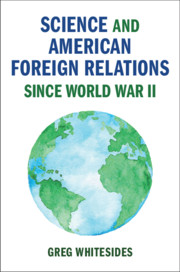Crossref Citations
This Book has been
cited by the following publications. This list is generated based on data provided by Crossref.
Zaidi, S. Waqar H.
2021.
Scientists as political experts: Atomic scientists and their claims for expertise on international relations, 1945–1947.
Centaurus,
Vol. 63,
Issue. 1,
p.
17.
Adamson, Matthew
and
Lalli, Roberto
2021.
Global perspectives on science diplomacy: Exploring the diplomacy‐knowledge nexus in contemporary histories of science.
Centaurus,
Vol. 63,
Issue. 1,
p.
1.
Roitto, Matti
Nevalainen, Pasi
and
Kaarkoski, Miina
2022.
Fuel for commercial politics: the nucleus of early commercial proliferation of atomic energy in three acts.
Business History,
Vol. 64,
Issue. 8,
p.
1510.
Kraft, Alison
2022.
From Dissent to Diplomacy: The Pugwash Project During the 1960s Cold War.
p.
1.
St. John, Edward P.
2023.
Higher Education in Post-Neoliberal Times: Building Human Capabilities in the Emergent Period of Uncertainty.
Education Sciences,
Vol. 13,
Issue. 5,
p.
500.
Yen, Hsiao-pei
2024.
Fossils and Sovereignty: Science Diplomacy and the Politics of Deep Time in the Sino-American Fossil Dispute of the 1920s.
Isis,
Vol. 115,
Issue. 1,
p.
1.
Barrett, Gordon
Edington, Claire
Homei, Aya
Sullivan de Estrada, Kate
and
Wang, Zuoyue
2024.
Concluding conversation: decentring science diplomacy.
The British Journal for the History of Science,
p.
1.





